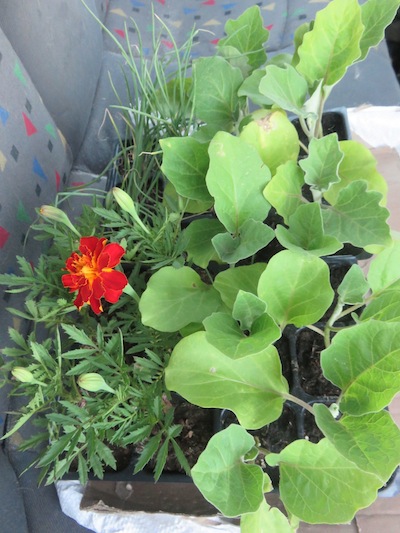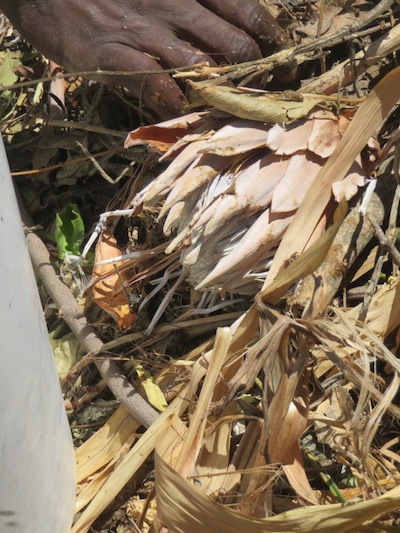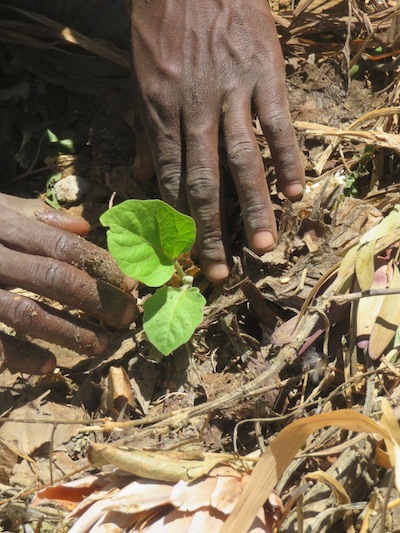Dear Reader, in this age of AI created content, please support with your goodwill someone who works harder to provide the human-made. Sign up at the top of the lefthand column or bottom of this page. You will receive my hand illustrated monthly newsletter RESTORE NATURE and access to the biodiversity garden design course as I write...and nothing else, I respect your time. I am also removing the advertizing as best I can as its become intrusive inappropriate and pays me nothing.
Soil work when its tough
veggies on rock hard clay
When soil work is hard… rock hard, you learn new tricks.
Sometimes soil work in a garden can be terribly hard. Digging, forking through, even planting small plants can be a trial, especially if the soil is dry clay, mixed with shattered shale 50 /50. As I transit from amateur to professional gardener, I see more gardens and I am presented with wider challenges. Something I’ve not had to deal with yet is this rock hard clay soil.
 The companions do not know what they are in for: eggplant, marigold, garlic chives waiting in the car
The companions do not know what they are in for: eggplant, marigold, garlic chives waiting in the carThis particular soil consists of shattered shale rock, in pieces from 1 to 20 cm across, with clay in the interstices. All around the garden are thriving plants, roses, irises, spinach, beetroot. The organic dressing or compost has blown away from large sections of the garden and the red soil is exposed. I never imagined it would be this hard till I tried to plant some seedlings.
I hammered away with the trowel, eventually resorting to alternate wetting and scraping till I had a hole about twice the size of the root ball. This is not good for a large vegetable like the eggplant. But there seemed to be nothing I can do. A spade rings on this rocky earth and bounces off. So does a massive garden fork.
 My gardening companion on this job, Moyo, spreading our wild, anything goes, whatever we can find, mulch
My gardening companion on this job, Moyo, spreading our wild, anything goes, whatever we can find, mulchTears of frustration sprout in my eyes along with the stinging salty sweat from the midday heat. There must be a way.
What to do to make the soil work in this garden easier ?
Returning home after the job, a quick search showed the writers on the interwebs favouring these solutions in order of popularity: tilling, mulching, adding gypsum, planting tough root veggies and adding bacteria.
Tilling would be impossible to do manually, we’d need a power driven machine, in such a tiny garden, it’s a bizarre, expensive idea. Even breaking the earth with spikes would be difficult in these cramped quarters up several steps. It also goes against the zero till ethos, and the front of the garden is part roof garden too, having a room underneath.
Mulching a lot till soil develops is probably what I will have to do. It seems that the previous permaculture designer in this garden added a very thick layer of compost and planted into that, doing his soil work in the compost, not into the soil itself. The rich clay nutrients could still be accessed by soil organisms and supply the plants. In the ensuing months the raging south easter winds blew away his compost in the front garden.
Adding gypsum can by done by breaking up and recycling old dry wall. Now there’s something. We don’t have much gypsum in our soils, it’s a nutrient that sometimes needs to be added anyway. Recycling is good.
I could also plant root vegetables, we will see what can survive here. Bacterial concoctions is a solution I love.
There is a worm farm on the property, and vermiculture may supply compost, nutrients and beneficial soil organisms.
Nonetheless, I’m filled with trepidation as I think about my poor but expensive seedlings, eggplant with garlic chives against cutworm and marigold against nematodes sitting in their little red clay sarcophagi. As a band aid in the interim until we get cubic meters of mulch delivered, we mulched wildly with any garden refuse we could find, including dried up proteas. Two hours later the little eggplants had not wilted. Some good is being done. I say a prayer for fertility now I’ve had time to cool down. This thing is going to be interesting. I am thankful for being stretched.
 I get to know Moyo who has a wonderful touch with plants
I get to know Moyo who has a wonderful touch with plants------
home page for links to tons of useful info on natural gardening
------
soil fertility, composting and other techniques
------
vegetable gardening and lists of easy vegetables
Restore Nature Newsletter
I've been writing for four years now and I would love to hear from you
Please let me know if you have any questions, comments or stories to share on gardening, permaculture, regenerative agriculture, food forests, natural gardening, do nothing gardening, observations about pests and diseases, foraging, dealing with and using weeds constructively, composting and going offgrid.
SEARCH
Order the Kindle E-book for the SPECIAL PRICE of only
Prices valid till 30.09.2023
Recent Articles
-
garden for life is a blog about saving the earth one garden at a time
Apr 18, 25 01:18 PM
The garden for life blog has short articles on gardening for biodiversity with native plants and regenerating soil for climate amelioration and nutritious food -
Cape Flats Sand Fynbos, Cape Town's most endangered native vegetation!
Apr 18, 25 10:36 AM
Cape Flats Sand Fynbos, a vegetation type found in the super diverse Cape Fynbos region is threatened by Cape Town's urban development and invasive alien plants -
Geography Research Task
Jan 31, 25 11:37 PM
To whom it may concern My name is Tanyaradzwa Madziwa and I am a matric student at Springfield Convent School. As part of our geography syllabus for this
"How to start a profitable worm business on a shoestring budget
Order a printed copy from "Amazon" at the SPECIAL PRICE of only
or a digital version from the "Kindle" store at the SPECIAL PRICE of only
Prices valid till 30.09.2023







